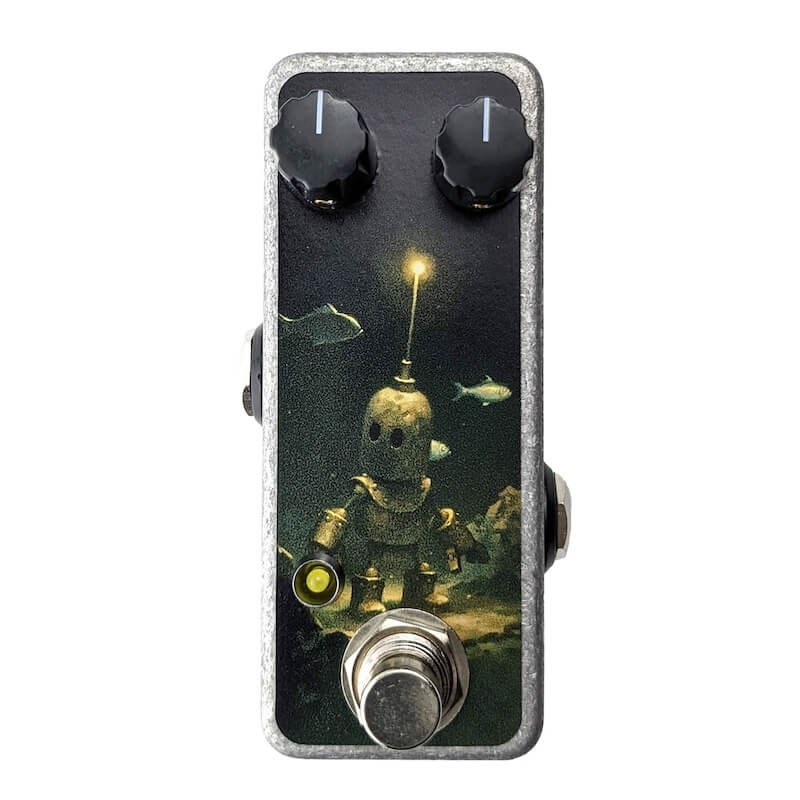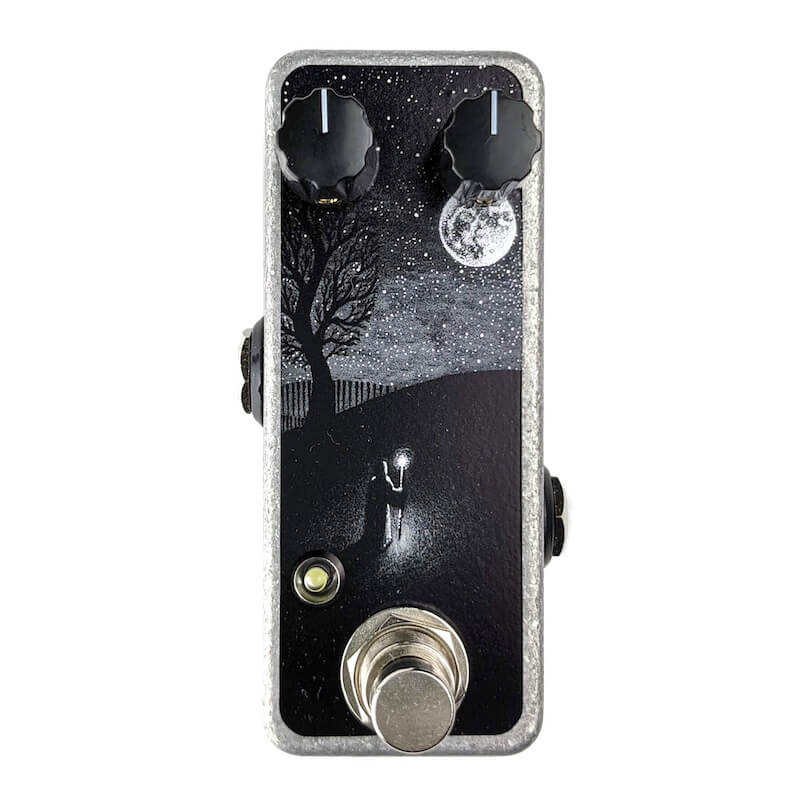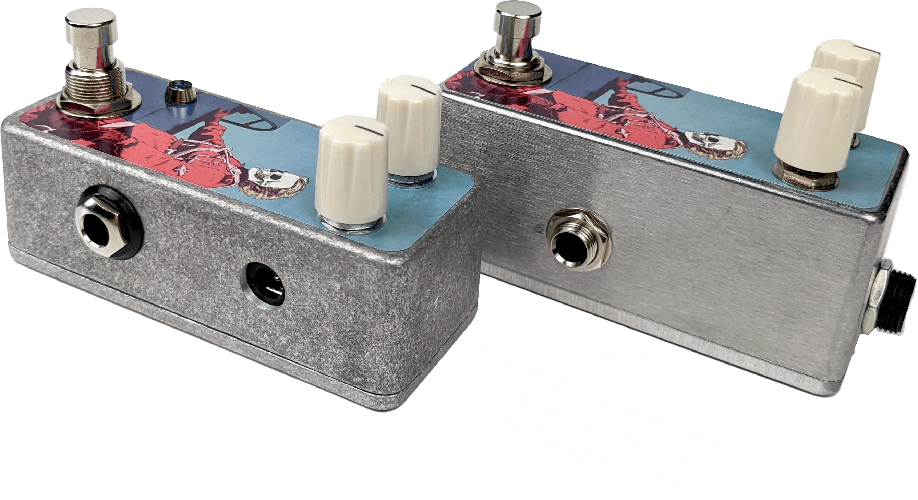Sweet, Sweet, Fuzz
Watch the demo videos below. Or learn about the audio circuit...
Watch the demo videos below. Or learn about the audio circuit...
Demo by Everyday Guitarist
Guitar & Bass demo by Justus Gash
Demo by Emily @ Get Offset

Upgrade available: glowing antenna (LED pokes through the sticker)
Shop In-Stock [$49 or $79] Customize [$59+]Upgrade available: glowing antenna (LED pokes through the sticker)

Upgrade available: glowing staff (glowing under the sticker)
Shop In-Stock [$49 or $79] Customize [$59+]If illustrations aren't quite your style, these feature wrap-around ink stamps. New designs will be occassionally available.
Or you can even request a plain one with no graphics, or customize yours with stamped letters.
Summary: V3 are the budget-friendly standard models listed above, and are now MORE affordable and include the LED. V2 are still available for custom builds, but discontinued for standard models.

Faced with sharply rising costs in the inflationary economy of 2022, while others responded by raising prices, MAS Effects went back to the drawing board to redesign the Tiny Fuzz: Illustrator Series to be less expensive, with more functionality (added LED indcator), while keeping the same great tone, top-notch build quality, and unusually generous Forever Warranty.
V3's fantastic price was accomplished primarily by switching to a standard-size (shorter) enclosure, decreasing the build time with a completely redesigned interior layout, and working with US-based metal shops who can more quickly and efficiently mill the enclosures.
| v3 | v2 | |
|---|---|---|
| Same great audio circuit | ✓ | ✓ |
| Same high quality | ✓ | ✓ |
| Standard Price | $49 | $59 and up
(discontinued) |
| LED indicator | ✓ | $10 add-on |
| Height | short (51mm) | tall (60mm) |
| Ambient lights: Semi-custom builds | N/A |
glowing eyes, etc [$79]
(still available) |
| Fully Custom builds | N/A | Still available [$59+] |
Making this pedal extremely affordable WITHOUT sacrificing quality has been a central focus from day one. It didn't just happen, but is the result of careful planning and many iterations.
1. Build time: I've gone through countless iterations of every aspect of this pedal and have progressively made it quicker and simpler to build. This includes everything: specialty-sized enclosure, specific hardware choices, circuit board layout and design, and more.
2. Trim the fat: The Tiny Fuzz is housed in a raw aluminum enclosure with a heavy duty vinyl sticker, which is far more economical - especially when offering so many designs to pick from - than traditional powder coating and UV printing. Not to mention it simply looks more interesting, and holds up to extreme abuse.
The packaging is lovely (if I do say so myself), but is handmade and economical. I'm not splurging on custom printed boxes, die cut foam/cardboard, or full color printed inserts.
3. Practical circuit design: The Tiny Fuzz was designed around commonly available, modern components (diodes, transistors, etc). You won't find any "unobtainium" parts in the pedal, purely for mojo.
You also won't find sub par, modern substitutions for vintage parts. Instead the best combinations of readily available components were auditioned and discovered through planning and experimentation.
4. Good business sense: Finally, I use common sense to keep overhead low (e.g. work from home, do most things myself, avoid frivolous expenses, etc)
Moreover, I don't do traditional advertising. Instead by putting a ton of effort into delighting customers and providing quick, personal attention I focus on driving word-of-mouth and referrals.
What sort of fuzz pedal is this?
Simple, no-nonsense fuzz pedal. It has a single voice that goes from all-out buzz saw down to a light break up (roll back that guitar volume!). It has an amazingly quiet, low noise floor, too.
The circuit that drives this is small, but deceptively complex and not a typical configuration. It uses a diode and transistor to provide asymmetric clipping, that is different distortion for the positive and negative halves of your guitar's signal. These two, plus a biasing and drain resistor work together in a very intertwined dance. This circuit behaves very differently depending on what specific values and components are chosen, so a lot of time and effort went into finding the optimal combinations.
NOTE: This pedal has a low input impedance (4.5k to 30k) which contributes to its characteristic thick and heavy sound. The trade off is that it may not play well with some pedals if it's placed after them. So try it out FIRST in your signal chain. Plug your guitar directly into this pedal.
Support a small business and independent illustrators with your purchase.
Illustrations:
The illustrations come from a variety of artists around the world. I encourage you to check out their websites, and buy prints and other products featuring their work. If you build a custom pedal you'll also have the option to buy an extra faceplate sticker and have 100% added to the artist's royalty.
Scroll up on this page to find links to each artist's site.
MAS Effects pedals:
These pedals are carefully and lovingly made in the USA (Lockport, IL) by Mark A. Stratman (@MAS_Effects).
MAS Effects has been making fun and unique guitar pedals and DIY parts since 2020. Feeling that the world doesn't need yet another company doing endless reissues of the same handful of circuits, MAS Effects was founded to focus on unmet niche needs, fun and quirky novelties, and opportunities to leverage digital expertise for amazing new effects and DIY utilities.
These are just a few. See them all in our shop
Simple and gnarly. Artwork and LED concept is top notch. I use it to add a touch of warmth to my sound but it's a sublime beast when cranked.
This is a great fuzz mini pedal at a great price. Sounds is awesome and the graphics on the pedal is just as sweet. I opted for the light up eyes on the monster under the bed and was so glad I did. It's super cool looking. Go get yourself one of these and be the envy of all your guitar playing buddies.
Just the right amount of crunch.